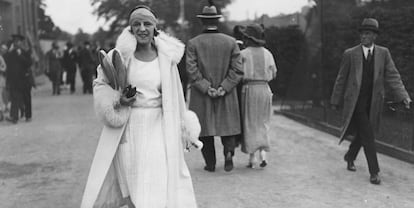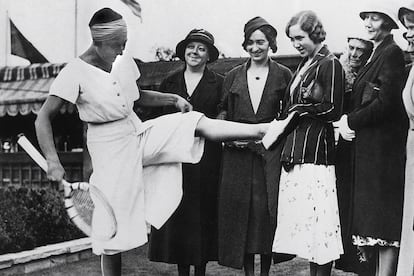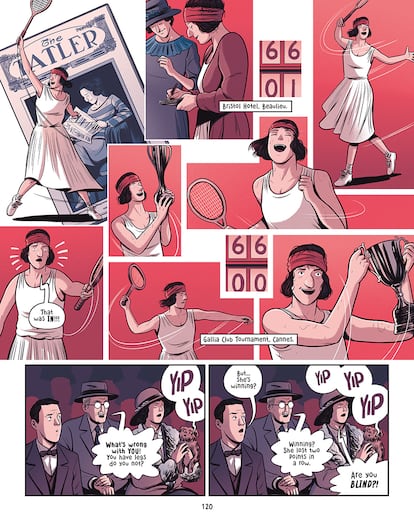Suzanne Lenglen, the ‘indecent and shameless’ tennis player who took on the sport’s most reactionary representatives
Winner of six Wimbledon titles, she took the tennis world by storm during the 1920s when she became a social icon on and off the courts. Thanks to her unmatched charisma and a style, she defied the standards of decorum and decency imposed on the women of her time

It was Janet Flanner, who summed up the irony of Suzanne Lenglen’s fate in her bi-weekly New Yorkercolumn, Letter from Paris: “She had storms all her life, but died peacefully.” In 1938, the French tennis player died prematurely of leukemia, which she had been diagnosed with just a few weeks earlier. She was only 39 years old, but that was more than enough time to change not only the sport of tennis as a whole but the reactionary society of her time. The six-time Wimbledon winner and three-time Olympic medalist, among many other titles, has been vindicated today both on and off the courts, having revolutionized sports fashion forever thanks to a style that was as charismatic, uninhibited and unreserved as it was contested among her contemporaries.

“Indecent” and “shameless.” Those were the adjectives that the British press used to describe Lenglen on her debut at the age of 20 on the courts of the All England Club, when she played — and won — her first Wimbledon. With neither a corset nor a petticoat, the woman known as La Divina stepped on the grass wearing a white cotton one-piece dress that left her shoulders, arms and calves exposed, a taboo for female tennis players at the time. She was also the first to play with painted lips and nails, sport a bob haircut and ditch the bulky, restrictive underwear. And instead of the classic wide-brimmed hats, Lenglen finished off her look with a colorful headband to match the cardigan she wore during the warm-up. The bandana, worn by most of the tennis players on the circuit almost a hundred years later, would sometimes boast polka-dot print or be adorned with small diamonds, and the young woman’s attention to fashion was such that she used to wear one color or another depending on which round of the tournament she was in. “The French champion sports an extraordinarily chic tennis look for the freedom, appropriateness and excellence of its simple lines,” Vogue magazine wrote about her in 1926. After winning the championship with unprecedented dominance and style, Lenglen returned the following year with an even shorter, pleated skirt made of translucent silk. Corsets were history for the other players too.

“I think there are very strong reasons to say that she completely revolutionized the way women dressed in the 20th century. Her mastery of the game coincided with a post-war society and the Roaring Twenties, which witnessed the development of sports and celebrity culture. People wanted a distraction. Lenglen was at the center of it all, and her personality and her beautiful style of play had an undeniable impact on the ‘it girls,’ garçonnes and flappers of the time. The sports fashion of one era became the casual fashion of the next,” Tom Humberstone, an intimate connoisseur of the French star, tells S Moda. In his graphic novel Suzanne: The Jazz Age Goddess of Tennis, the illustrator introduces new generations to the revolutionary story of the person after whom the second-largest court at the Roland Garros stadium is named, and who lost only one match between 1919 and 1926.
The artist calls Lenglen the inventor of the flapper aesthetic, which would divert the media spotlight from the aristocracy to movie and music stars and challenged the beauty ideals of the time with a pompous and transgressive spirit, starring makeup and jewelry. As hedonistic as she was temperamental, the tennis player became the ultimate paradigm of the trend, with her shots of cognac between games and her familiar ermine coat on her way to the club. Humberstone calls it her most iconic garment, and not by chance. “Her father, Charles Lenglen, insisted that she wear ermine coats because he thought they evoked royalty. It is a garment that denotes the success Lenglen always pursued and her father’s dominant influence on her.”

Behind Suzanne’s influence and social impact was designer Jean Patou, who turned the tennis player into a muse and poster girl for his daring bid to popularize sports fashion. “My garments are conceived for the practice of sport. I try to make them as pleasant to look at as they are to wear and allow great freedom of movement,” said the bon vivant who would rival Coco Chanel for dominance of the Parisian fashion scene. Although Patou clearly lost the battle for a place in the collective memory to Chanel, he did manage to establish this proto-athleisure on the streets of the French capital. “Three-quarters of the daytime fashions seen in Paris today are sportswear. Simple, practical, and youthful, it is an influence that feels increasingly removed from the realm of active sports in favor of daywear in general, for vacations and travel,” said Vogue.

“Between them, Chanel and Patou designed most of the tennis players’ looks of the 1920s and one could even establish a link between their rivalry and today’s competition between sports brands like Nike and Adidas. The two designers blazed a trail in fashion, and yet most people only know the name Chanel. And that’s another parallel with Lenglen. She was the most popular athlete of her time — and probably the most famous celebrity too — yet today few people know her name and her legacy,” the illustrator says.
The relationship between tennis and fashion is as long-lived as it is fruitful. There is the historical validity of firms created by tennis players such as René Lacoste and Fred Perry, the timelessness of Stan Smith — an American player from the seventies — and even the unstoppable stock market and revenue growth of On, the brand that counts Roger Federer as a shareholder and its public face. However, journalist Hannah Jane Parkinson argues in The Guardian that tennis fashion “owes everything” to the stormy Lenglen. “Her influence on the status of tanned skin meant a renaissance in swimsuit design, which showed an increasing amount of skin. Her unique white canvas sneakers inspired unisex spin-offs of the ‘Lenglen shoe,’ a precursor to the Adidas Stan Smith that retailers branded ‘light, stylish and practical.’ The female form was beginning to break free.”

Sign up for our weekly newsletter to get more English-language news coverage from EL PAÍS USA Edition









































